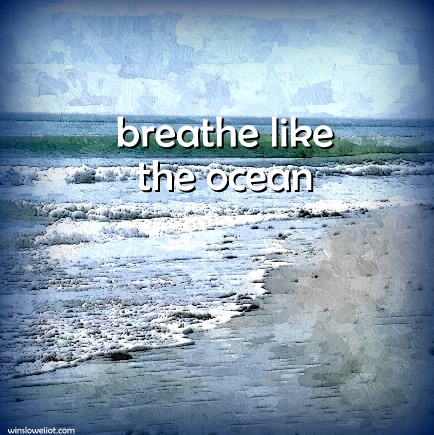
Stillness 7-18: Without breath there is no life. Breath is the essence of our existence, as we know from that first shocking gulp of air we take when we are born. And the real measure of our death is not being brain dead, or even our heart stopping (since it’s been known to start up again) … but when we release our last breath. That is, literally, our moment of expiration.
While we live, we breathe, and there are many ways to do this. Most of the time we breathe automatically, without thinking about it or noticing the process. When we’re anxious, our breath may become hasty and shallow, which then sends waves of worry to our brain. Our brain, in turn, sends its waves of worry to our heart, where our Self resides. Uh-oh. But when we breathe deeply and calmly, our brain is soothed and the worry dissipates. Do you wake up anxious? Breathe deeply a few times—your brain will calm down and then so will you. The way we breathe has an immediate and powerful effect on us.
My favorite breathing technique is called Ocean Breath (or Ujjayi in Sanscrit). My beloved yoga teacher taught this to me many years ago and I continue to incorporate it into my daily yoga and meditation practice, mainly because I love it so much. I enjoy it not only for its beneficial mental and emotional effects, but because the actual experience of doing it feels so pleasant. I’m instantly transported to a lovely, quiet beach, where I’m relaxing by the edge of the waves, listening to them approach, curl over, whisper on the sand, and susurrate back out to sea. My breath becomes the sound of the sea and I become one with a vast ocean. Yes, afterward I also feel peaceful and refreshed, but it’s the breathing practice itself that feels particularly lovely.
The basic technique of Ocean Breath consists of slightly closing the back of your throat so your breathing makes an ocean sound as it passes in and out of your body. As always in any meditation, begin by breathing deeply and slowly into your lungs and abdomen a few times as you grow consciously still. Then gradually return to breathing normally, relaxing your body completely. If you’re feeling extra-tense or unsettled, touch the roof of your mouth with the tip of your tongue and keep it there as you practice—there are nerve-endings located there that help calm your nervous system. Then inhale and exhale slowly through your nose, slightly closing the back of your throat so your breathing sounds like waves ebbing and flowing. Be aware only of the sound of your breath. If a thought bobs toward you like a cork in the foam, let it come and then let it bob away again as you return your awareness to the sound of your breathing.
If you don’t already incorporate a breathing practice in your daily meditation, begin now. Breathe into stillness. Breathe more deeply into stillness. Then stillness becomes breath, and breath becomes stillness, and you become aware—simply and profoundly—of awareness itself.
